Financial Analysis Report: Reliance Worldwide Corporation Limited
VerifiedAdded on 2021/05/31
|25
|4658
|95
Report
AI Summary
This report offers a detailed financial analysis of Reliance Worldwide Corporation Limited (RWC), evaluating its performance from 2015 to 2017. The analysis encompasses a range of financial ratios, including liquidity (current, quick, and working capital ratios), long-term solvency (debt-to-equity, debt-to-total assets), profitability (net profit margin, total asset turnover, return on assets, and return on equity), and cash flow ratios. The report examines trends in these ratios to assess RWC's financial health, highlighting areas of strength and weakness. Key findings include observations on liquidity, solvency, and profitability trends, and the report also discusses the risks faced by the company. The analysis provides insights into RWC's financial position and potential investment considerations, making it a valuable resource for understanding the company's financial performance.
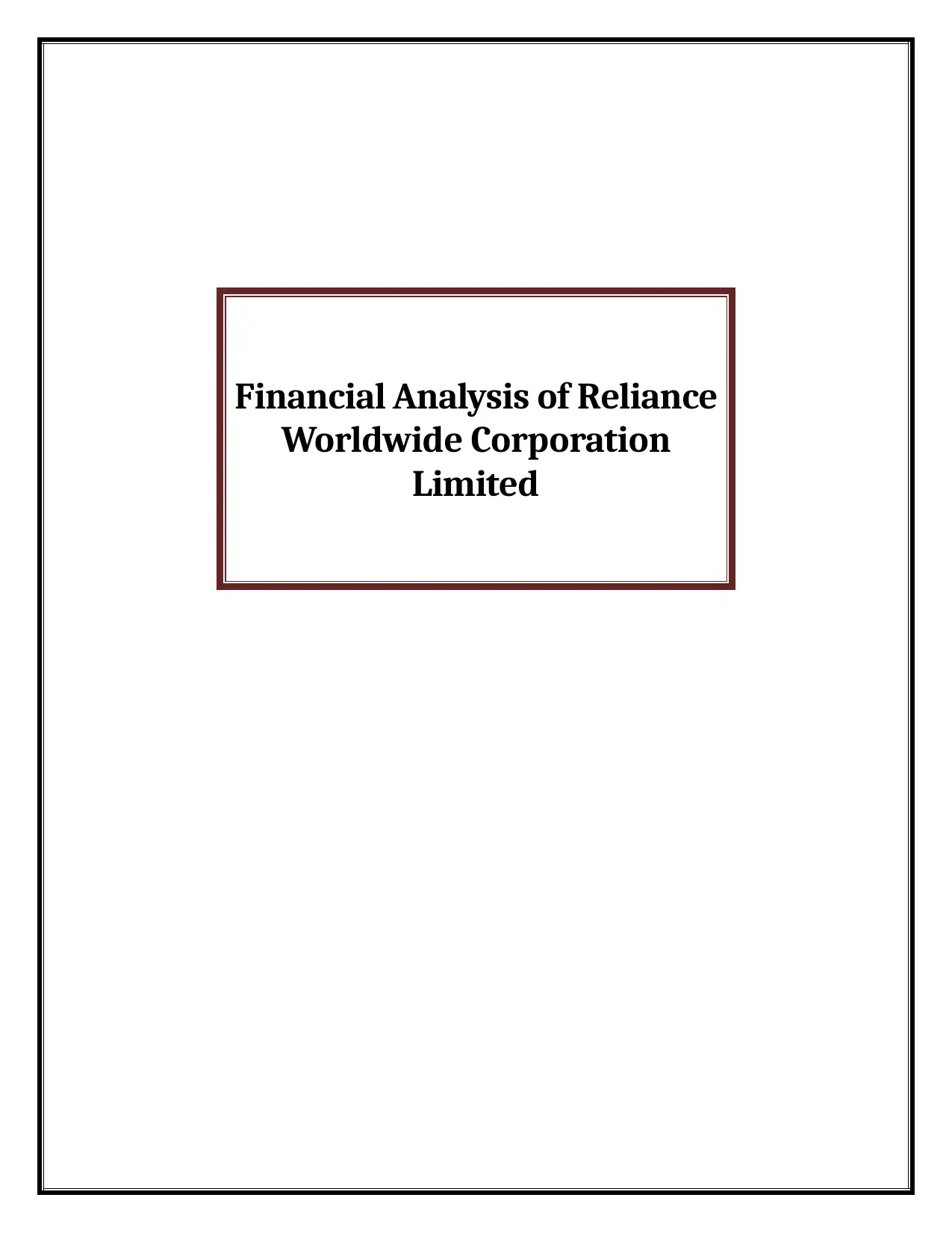
Financial Analysis of Reliance
Worldwide Corporation
Limited
Worldwide Corporation
Limited
Paraphrase This Document
Need a fresh take? Get an instant paraphrase of this document with our AI Paraphraser
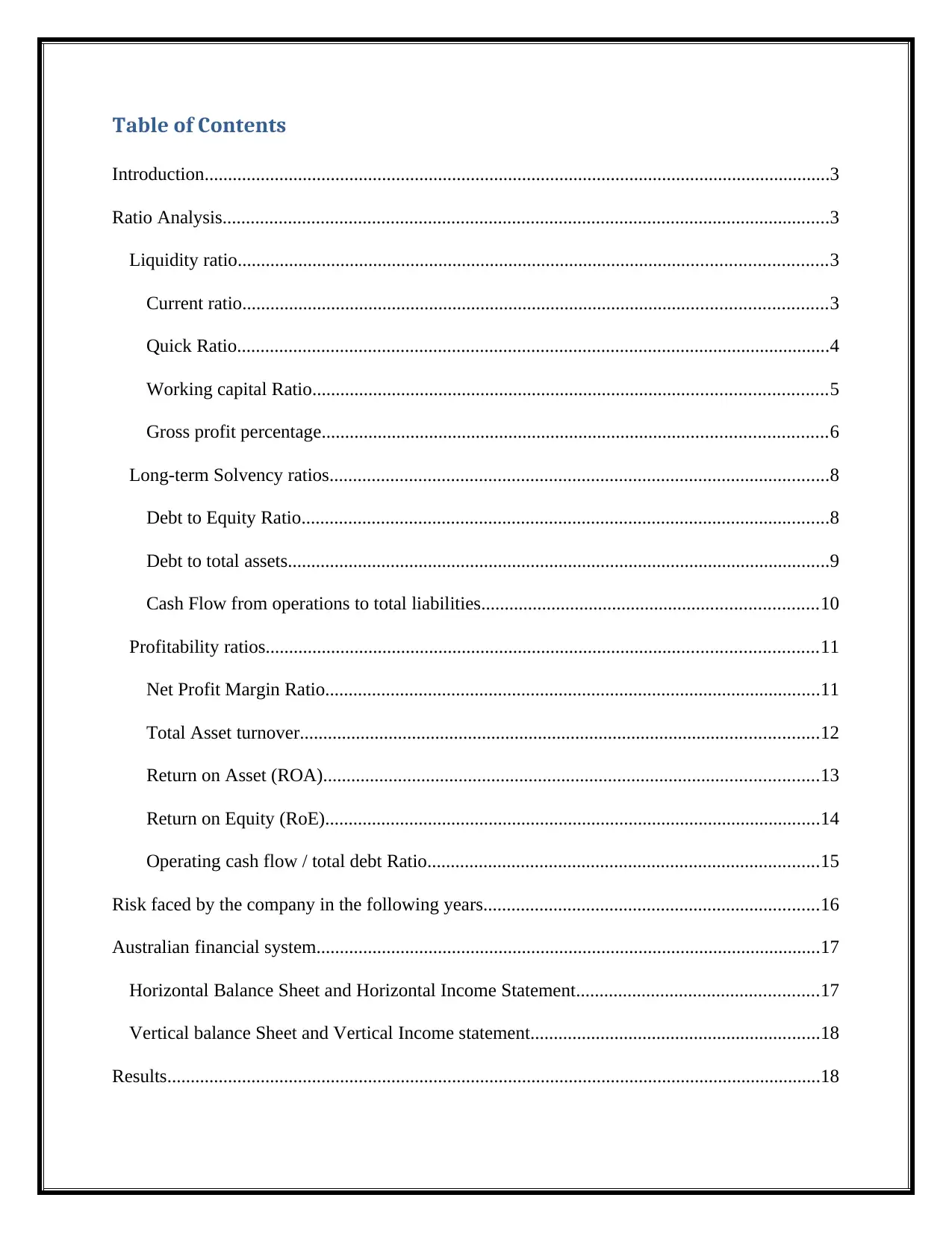
Table of Contents
Introduction......................................................................................................................................3
Ratio Analysis..................................................................................................................................3
Liquidity ratio..............................................................................................................................3
Current ratio.............................................................................................................................3
Quick Ratio...............................................................................................................................4
Working capital Ratio..............................................................................................................5
Gross profit percentage............................................................................................................6
Long-term Solvency ratios...........................................................................................................8
Debt to Equity Ratio.................................................................................................................8
Debt to total assets....................................................................................................................9
Cash Flow from operations to total liabilities........................................................................10
Profitability ratios......................................................................................................................11
Net Profit Margin Ratio..........................................................................................................11
Total Asset turnover...............................................................................................................12
Return on Asset (ROA)..........................................................................................................13
Return on Equity (RoE)..........................................................................................................14
Operating cash flow / total debt Ratio....................................................................................15
Risk faced by the company in the following years........................................................................16
Australian financial system............................................................................................................17
Horizontal Balance Sheet and Horizontal Income Statement....................................................17
Vertical balance Sheet and Vertical Income statement..............................................................18
Results............................................................................................................................................18
Introduction......................................................................................................................................3
Ratio Analysis..................................................................................................................................3
Liquidity ratio..............................................................................................................................3
Current ratio.............................................................................................................................3
Quick Ratio...............................................................................................................................4
Working capital Ratio..............................................................................................................5
Gross profit percentage............................................................................................................6
Long-term Solvency ratios...........................................................................................................8
Debt to Equity Ratio.................................................................................................................8
Debt to total assets....................................................................................................................9
Cash Flow from operations to total liabilities........................................................................10
Profitability ratios......................................................................................................................11
Net Profit Margin Ratio..........................................................................................................11
Total Asset turnover...............................................................................................................12
Return on Asset (ROA)..........................................................................................................13
Return on Equity (RoE)..........................................................................................................14
Operating cash flow / total debt Ratio....................................................................................15
Risk faced by the company in the following years........................................................................16
Australian financial system............................................................................................................17
Horizontal Balance Sheet and Horizontal Income Statement....................................................17
Vertical balance Sheet and Vertical Income statement..............................................................18
Results............................................................................................................................................18
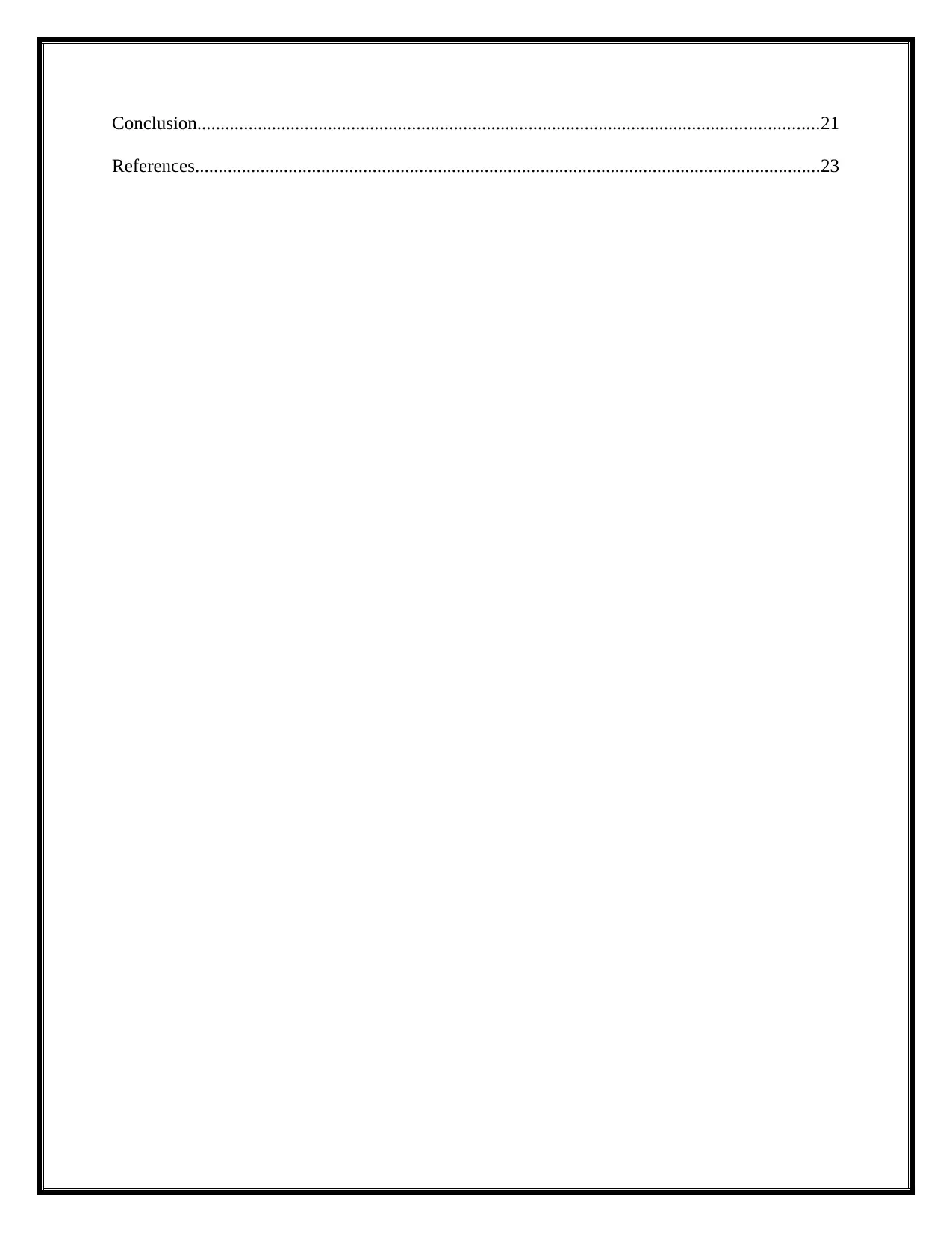
Conclusion.....................................................................................................................................21
References......................................................................................................................................23
References......................................................................................................................................23
⊘ This is a preview!⊘
Do you want full access?
Subscribe today to unlock all pages.

Trusted by 1+ million students worldwide
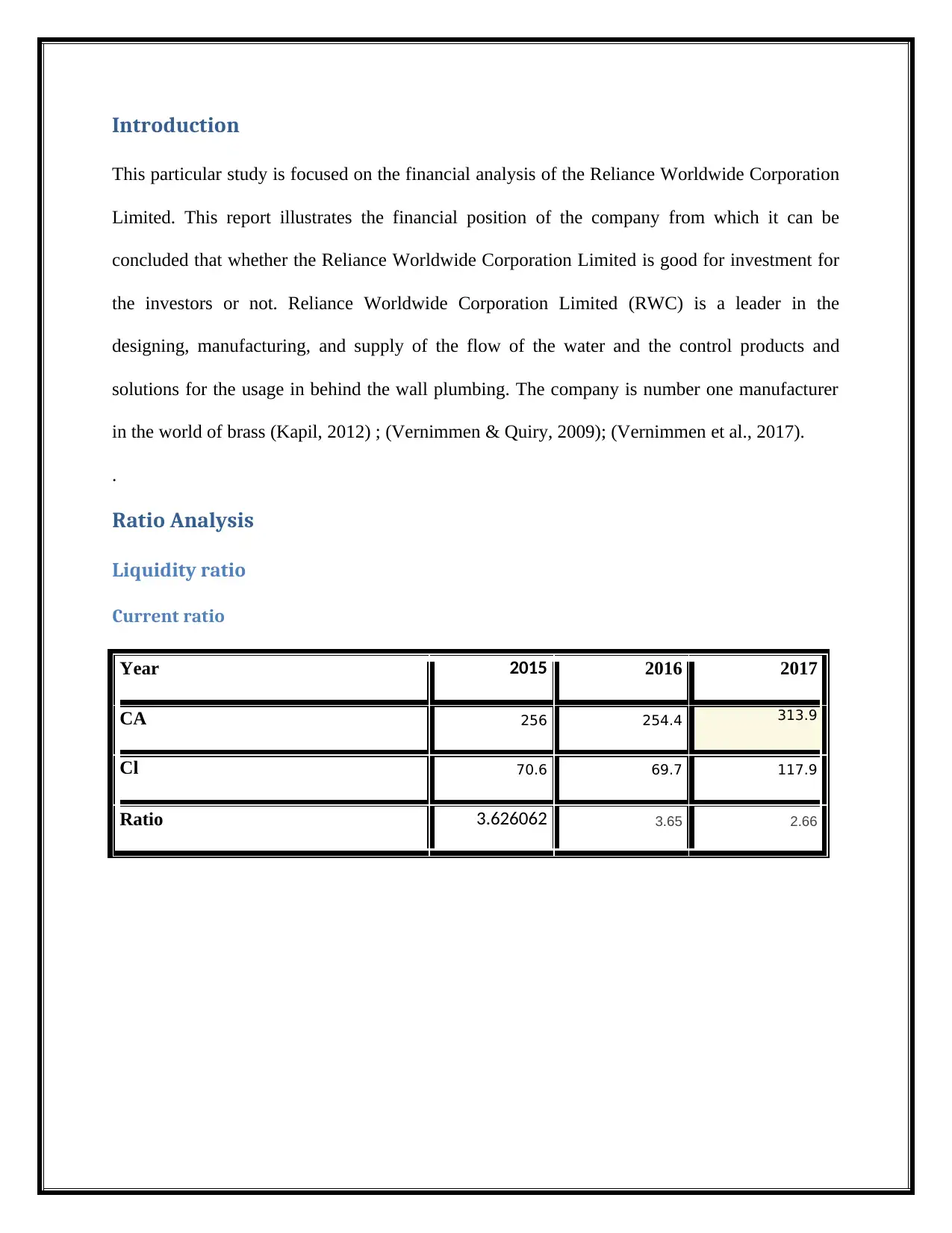
Introduction
This particular study is focused on the financial analysis of the Reliance Worldwide Corporation
Limited. This report illustrates the financial position of the company from which it can be
concluded that whether the Reliance Worldwide Corporation Limited is good for investment for
the investors or not. Reliance Worldwide Corporation Limited (RWC) is a leader in the
designing, manufacturing, and supply of the flow of the water and the control products and
solutions for the usage in behind the wall plumbing. The company is number one manufacturer
in the world of brass (Kapil, 2012) ; (Vernimmen & Quiry, 2009); (Vernimmen et al., 2017).
.
Ratio Analysis
Liquidity ratio
Current ratio
Year 2015 2016 2017
CA 256 254.4 313.9
Cl 70.6 69.7 117.9
Ratio 3.626062 3.65 2.66
This particular study is focused on the financial analysis of the Reliance Worldwide Corporation
Limited. This report illustrates the financial position of the company from which it can be
concluded that whether the Reliance Worldwide Corporation Limited is good for investment for
the investors or not. Reliance Worldwide Corporation Limited (RWC) is a leader in the
designing, manufacturing, and supply of the flow of the water and the control products and
solutions for the usage in behind the wall plumbing. The company is number one manufacturer
in the world of brass (Kapil, 2012) ; (Vernimmen & Quiry, 2009); (Vernimmen et al., 2017).
.
Ratio Analysis
Liquidity ratio
Current ratio
Year 2015 2016 2017
CA 256 254.4 313.9
Cl 70.6 69.7 117.9
Ratio 3.626062 3.65 2.66
Paraphrase This Document
Need a fresh take? Get an instant paraphrase of this document with our AI Paraphraser
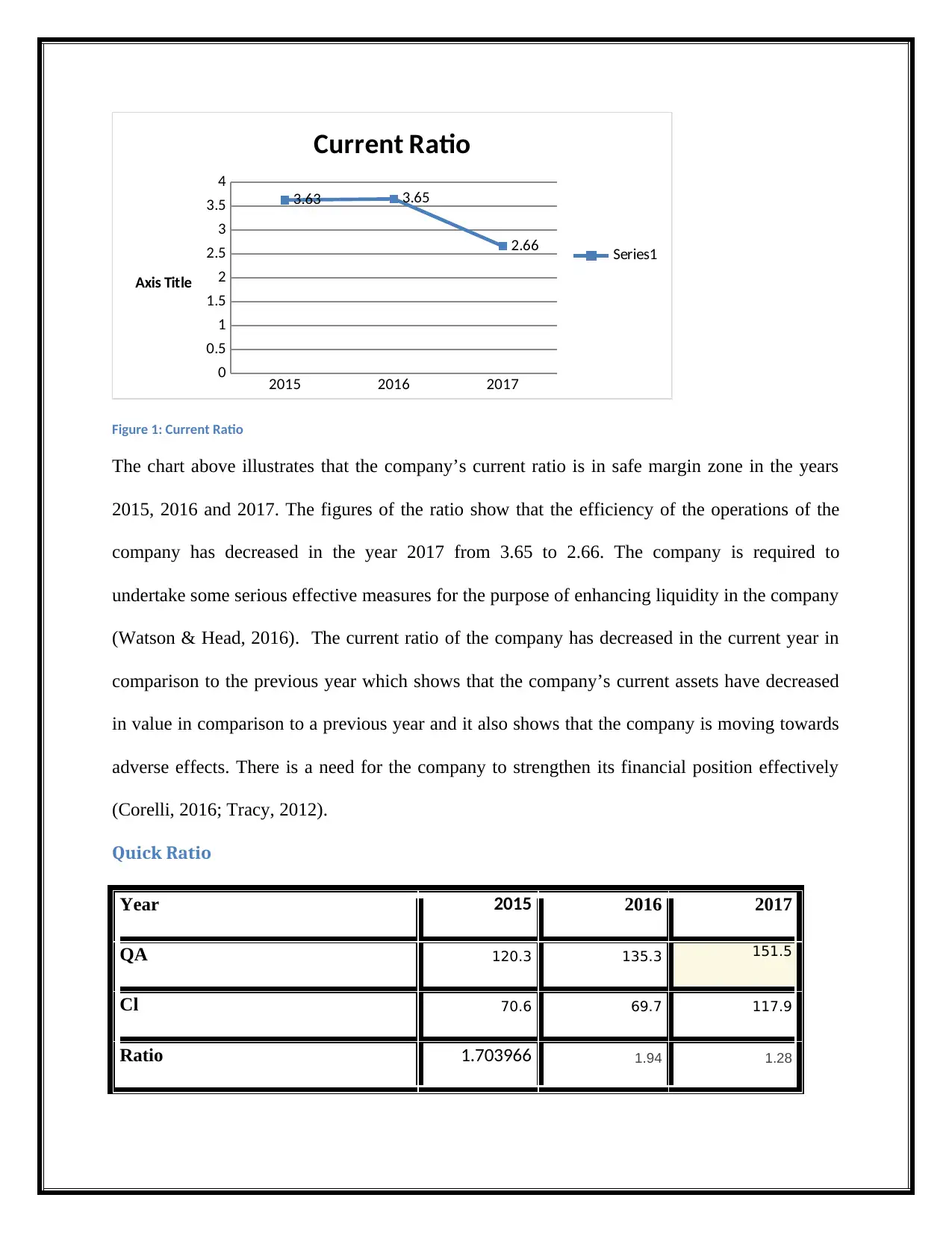
2015 2016 2017
0
0.5
1
1.5
2
2.5
3
3.5
4
3.63 3.65
2.66
Current Ratio
Series1
Axis Title
Figure 1: Current Ratio
The chart above illustrates that the company’s current ratio is in safe margin zone in the years
2015, 2016 and 2017. The figures of the ratio show that the efficiency of the operations of the
company has decreased in the year 2017 from 3.65 to 2.66. The company is required to
undertake some serious effective measures for the purpose of enhancing liquidity in the company
(Watson & Head, 2016). The current ratio of the company has decreased in the current year in
comparison to the previous year which shows that the company’s current assets have decreased
in value in comparison to a previous year and it also shows that the company is moving towards
adverse effects. There is a need for the company to strengthen its financial position effectively
(Corelli, 2016; Tracy, 2012).
Quick Ratio
Year 2015 2016 2017
QA 120.3 135.3 151.5
Cl 70.6 69.7 117.9
Ratio 1.703966 1.94 1.28
0
0.5
1
1.5
2
2.5
3
3.5
4
3.63 3.65
2.66
Current Ratio
Series1
Axis Title
Figure 1: Current Ratio
The chart above illustrates that the company’s current ratio is in safe margin zone in the years
2015, 2016 and 2017. The figures of the ratio show that the efficiency of the operations of the
company has decreased in the year 2017 from 3.65 to 2.66. The company is required to
undertake some serious effective measures for the purpose of enhancing liquidity in the company
(Watson & Head, 2016). The current ratio of the company has decreased in the current year in
comparison to the previous year which shows that the company’s current assets have decreased
in value in comparison to a previous year and it also shows that the company is moving towards
adverse effects. There is a need for the company to strengthen its financial position effectively
(Corelli, 2016; Tracy, 2012).
Quick Ratio
Year 2015 2016 2017
QA 120.3 135.3 151.5
Cl 70.6 69.7 117.9
Ratio 1.703966 1.94 1.28
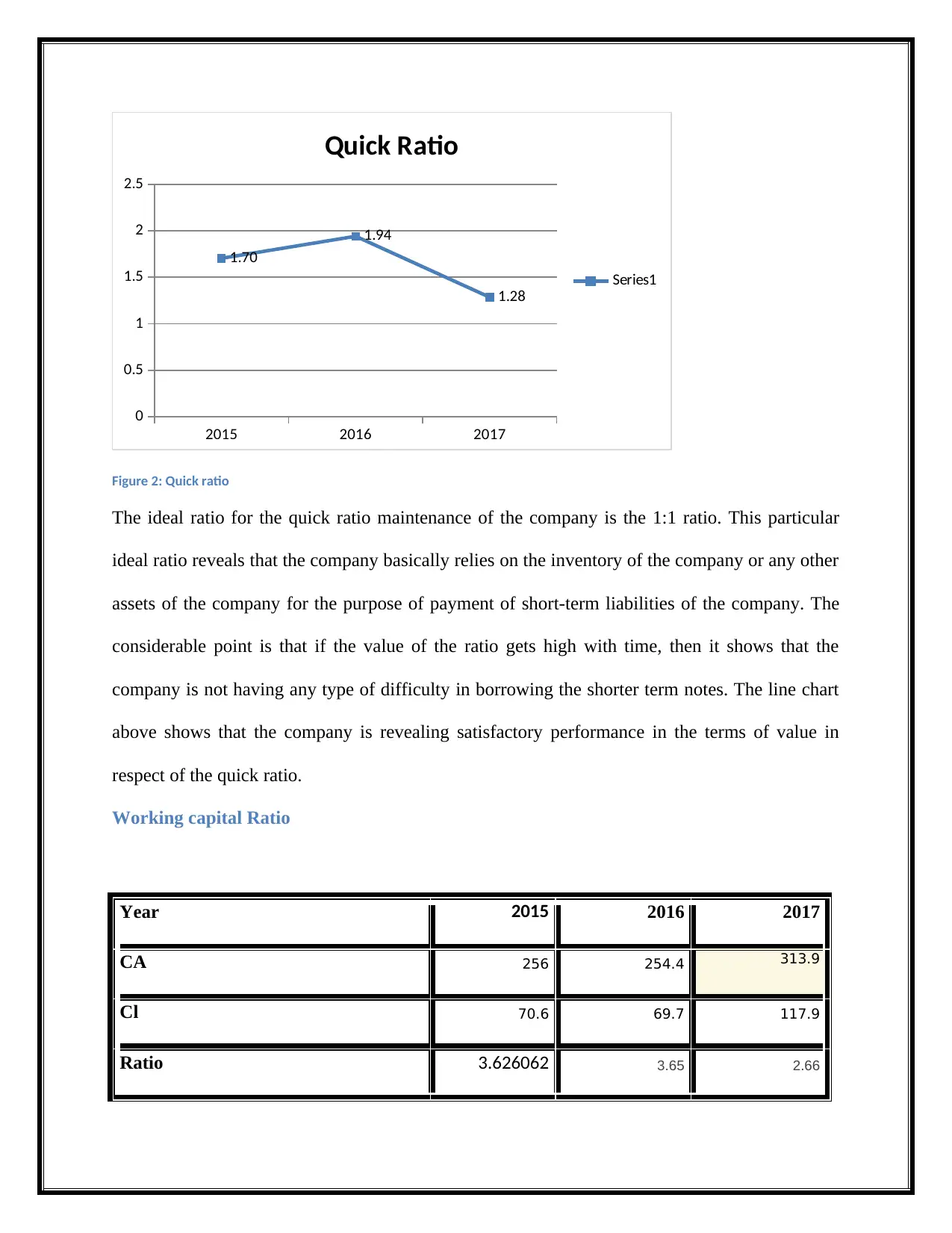
2015 2016 2017
0
0.5
1
1.5
2
2.5
1.70
1.94
1.28
Quick Ratio
Series1
Figure 2: Quick ratio
The ideal ratio for the quick ratio maintenance of the company is the 1:1 ratio. This particular
ideal ratio reveals that the company basically relies on the inventory of the company or any other
assets of the company for the purpose of payment of short-term liabilities of the company. The
considerable point is that if the value of the ratio gets high with time, then it shows that the
company is not having any type of difficulty in borrowing the shorter term notes. The line chart
above shows that the company is revealing satisfactory performance in the terms of value in
respect of the quick ratio.
Working capital Ratio
Year 2015 2016 2017
CA 256 254.4 313.9
Cl 70.6 69.7 117.9
Ratio 3.626062 3.65 2.66
0
0.5
1
1.5
2
2.5
1.70
1.94
1.28
Quick Ratio
Series1
Figure 2: Quick ratio
The ideal ratio for the quick ratio maintenance of the company is the 1:1 ratio. This particular
ideal ratio reveals that the company basically relies on the inventory of the company or any other
assets of the company for the purpose of payment of short-term liabilities of the company. The
considerable point is that if the value of the ratio gets high with time, then it shows that the
company is not having any type of difficulty in borrowing the shorter term notes. The line chart
above shows that the company is revealing satisfactory performance in the terms of value in
respect of the quick ratio.
Working capital Ratio
Year 2015 2016 2017
CA 256 254.4 313.9
Cl 70.6 69.7 117.9
Ratio 3.626062 3.65 2.66
⊘ This is a preview!⊘
Do you want full access?
Subscribe today to unlock all pages.

Trusted by 1+ million students worldwide
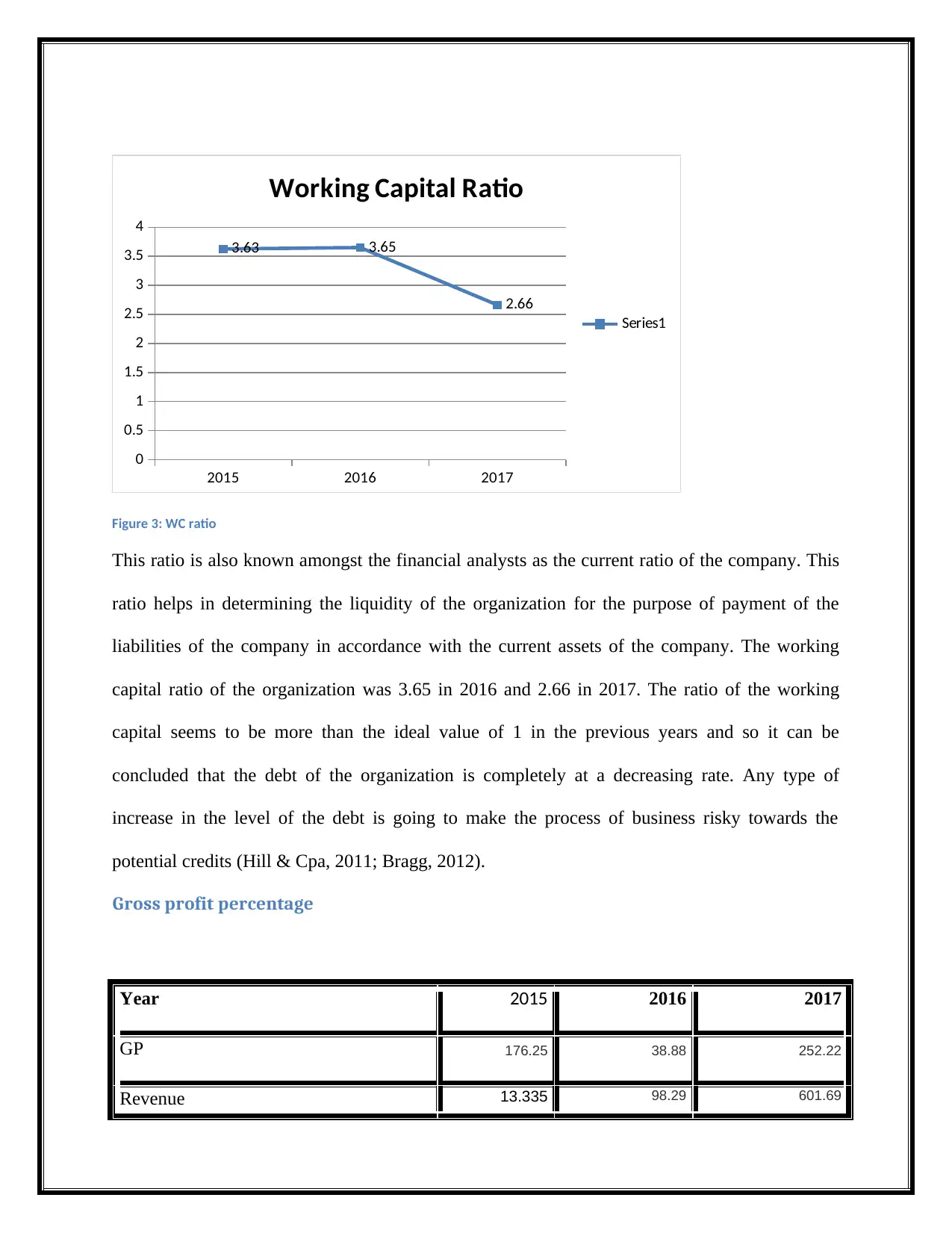
2015 2016 2017
0
0.5
1
1.5
2
2.5
3
3.5
4
3.63 3.65
2.66
Working Capital Ratio
Series1
Figure 3: WC ratio
This ratio is also known amongst the financial analysts as the current ratio of the company. This
ratio helps in determining the liquidity of the organization for the purpose of payment of the
liabilities of the company in accordance with the current assets of the company. The working
capital ratio of the organization was 3.65 in 2016 and 2.66 in 2017. The ratio of the working
capital seems to be more than the ideal value of 1 in the previous years and so it can be
concluded that the debt of the organization is completely at a decreasing rate. Any type of
increase in the level of the debt is going to make the process of business risky towards the
potential credits (Hill & Cpa, 2011; Bragg, 2012).
Gross profit percentage
Year 2015 2016 2017
GP 176.25 38.88 252.22
Revenue 13.335 98.29 601.69
0
0.5
1
1.5
2
2.5
3
3.5
4
3.63 3.65
2.66
Working Capital Ratio
Series1
Figure 3: WC ratio
This ratio is also known amongst the financial analysts as the current ratio of the company. This
ratio helps in determining the liquidity of the organization for the purpose of payment of the
liabilities of the company in accordance with the current assets of the company. The working
capital ratio of the organization was 3.65 in 2016 and 2.66 in 2017. The ratio of the working
capital seems to be more than the ideal value of 1 in the previous years and so it can be
concluded that the debt of the organization is completely at a decreasing rate. Any type of
increase in the level of the debt is going to make the process of business risky towards the
potential credits (Hill & Cpa, 2011; Bragg, 2012).
Gross profit percentage
Year 2015 2016 2017
GP 176.25 38.88 252.22
Revenue 13.335 98.29 601.69
Paraphrase This Document
Need a fresh take? Get an instant paraphrase of this document with our AI Paraphraser
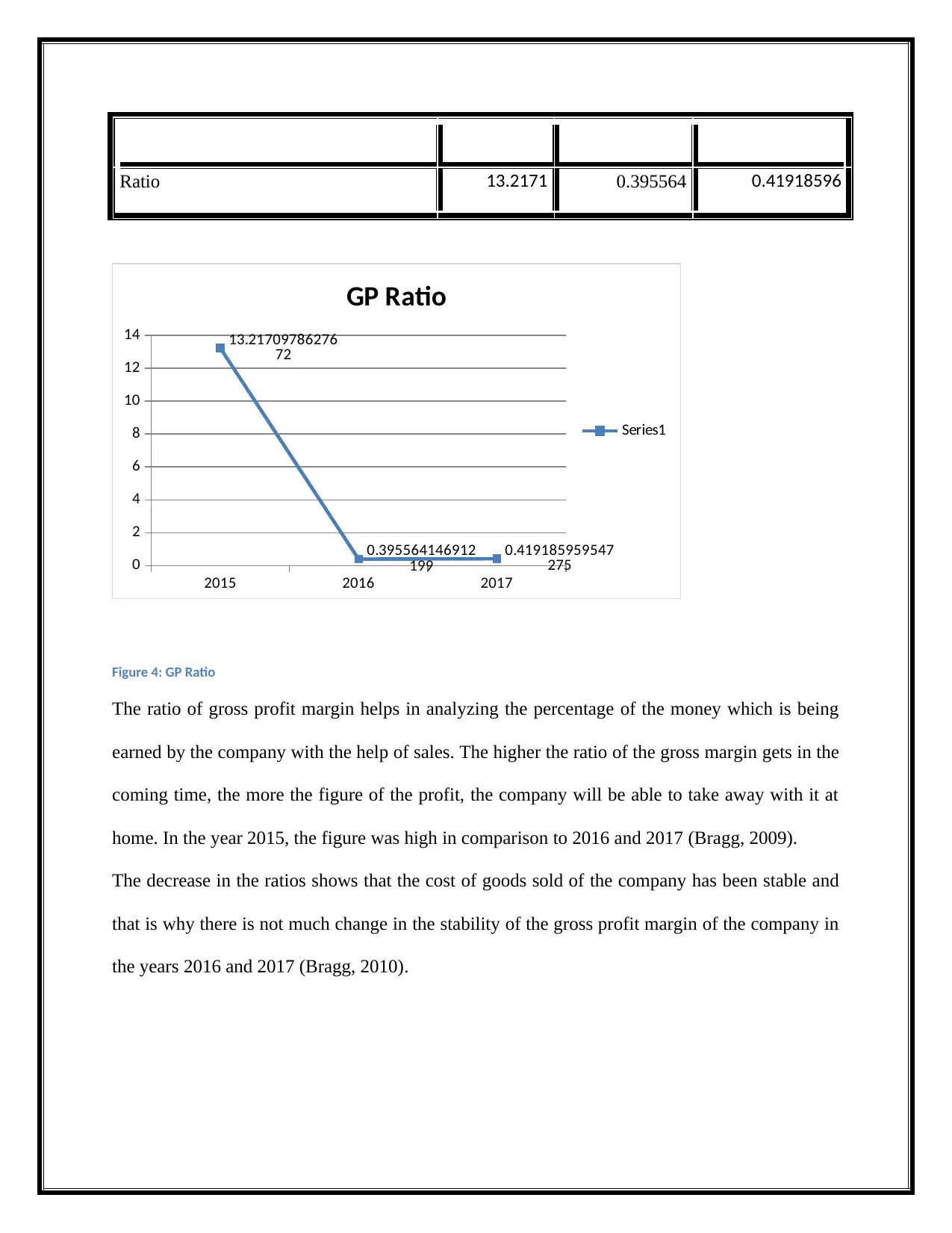
Ratio 13.2171 0.395564 0.41918596
2015 2016 2017
0
2
4
6
8
10
12
14 13.21709786276
72
0.395564146912
199 0.419185959547
275
GP Ratio
Series1
Figure 4: GP Ratio
The ratio of gross profit margin helps in analyzing the percentage of the money which is being
earned by the company with the help of sales. The higher the ratio of the gross margin gets in the
coming time, the more the figure of the profit, the company will be able to take away with it at
home. In the year 2015, the figure was high in comparison to 2016 and 2017 (Bragg, 2009).
The decrease in the ratios shows that the cost of goods sold of the company has been stable and
that is why there is not much change in the stability of the gross profit margin of the company in
the years 2016 and 2017 (Bragg, 2010).
2015 2016 2017
0
2
4
6
8
10
12
14 13.21709786276
72
0.395564146912
199 0.419185959547
275
GP Ratio
Series1
Figure 4: GP Ratio
The ratio of gross profit margin helps in analyzing the percentage of the money which is being
earned by the company with the help of sales. The higher the ratio of the gross margin gets in the
coming time, the more the figure of the profit, the company will be able to take away with it at
home. In the year 2015, the figure was high in comparison to 2016 and 2017 (Bragg, 2009).
The decrease in the ratios shows that the cost of goods sold of the company has been stable and
that is why there is not much change in the stability of the gross profit margin of the company in
the years 2016 and 2017 (Bragg, 2010).
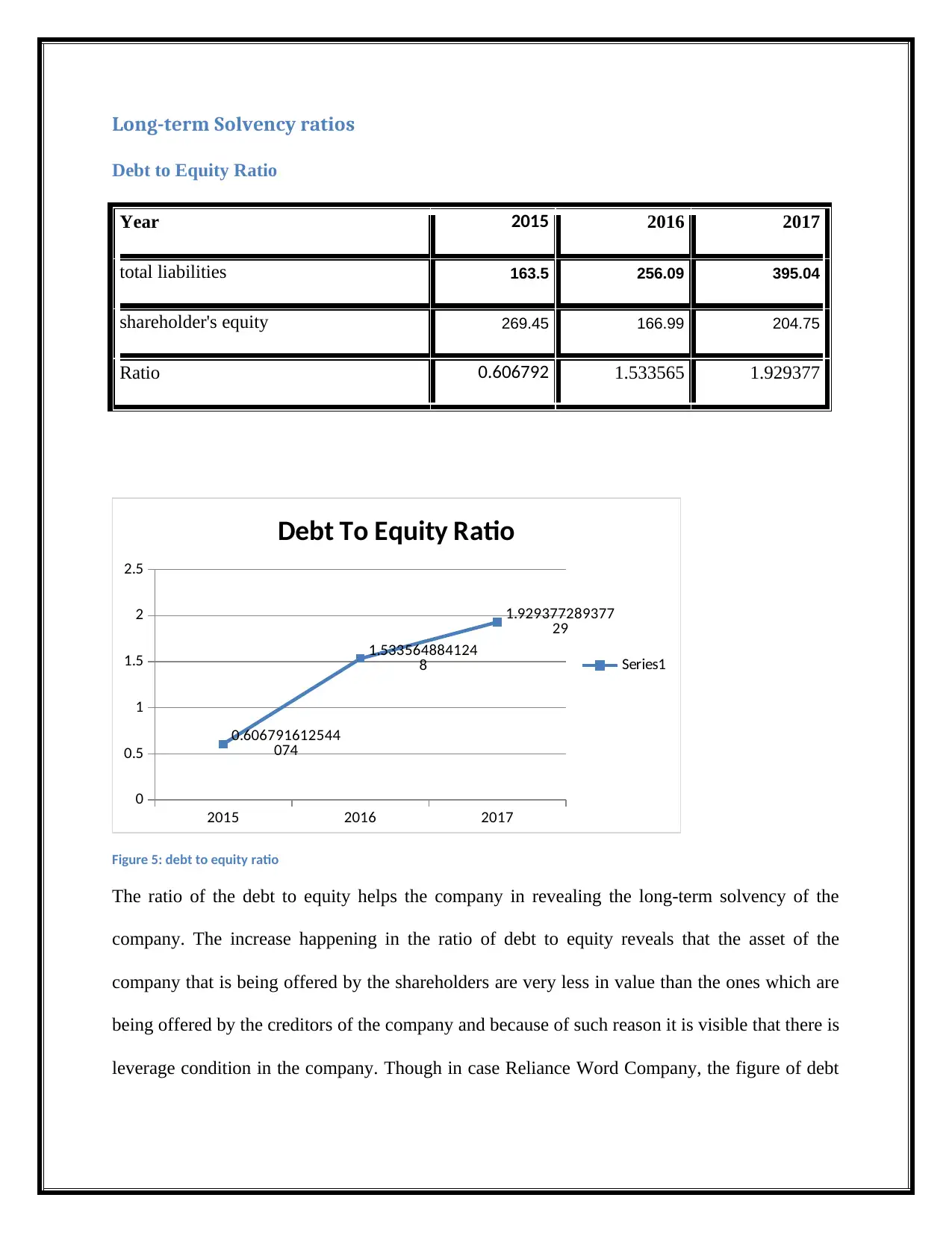
Long-term Solvency ratios
Debt to Equity Ratio
Year 2015 2016 2017
total liabilities 163.5 256.09 395.04
shareholder's equity 269.45 166.99 204.75
Ratio 0.606792 1.533565 1.929377
2015 2016 2017
0
0.5
1
1.5
2
2.5
0.606791612544
074
1.533564884124
8
1.929377289377
29
Debt To Equity Ratio
Series1
Figure 5: debt to equity ratio
The ratio of the debt to equity helps the company in revealing the long-term solvency of the
company. The increase happening in the ratio of debt to equity reveals that the asset of the
company that is being offered by the shareholders are very less in value than the ones which are
being offered by the creditors of the company and because of such reason it is visible that there is
leverage condition in the company. Though in case Reliance Word Company, the figure of debt
Debt to Equity Ratio
Year 2015 2016 2017
total liabilities 163.5 256.09 395.04
shareholder's equity 269.45 166.99 204.75
Ratio 0.606792 1.533565 1.929377
2015 2016 2017
0
0.5
1
1.5
2
2.5
0.606791612544
074
1.533564884124
8
1.929377289377
29
Debt To Equity Ratio
Series1
Figure 5: debt to equity ratio
The ratio of the debt to equity helps the company in revealing the long-term solvency of the
company. The increase happening in the ratio of debt to equity reveals that the asset of the
company that is being offered by the shareholders are very less in value than the ones which are
being offered by the creditors of the company and because of such reason it is visible that there is
leverage condition in the company. Though in case Reliance Word Company, the figure of debt
⊘ This is a preview!⊘
Do you want full access?
Subscribe today to unlock all pages.

Trusted by 1+ million students worldwide
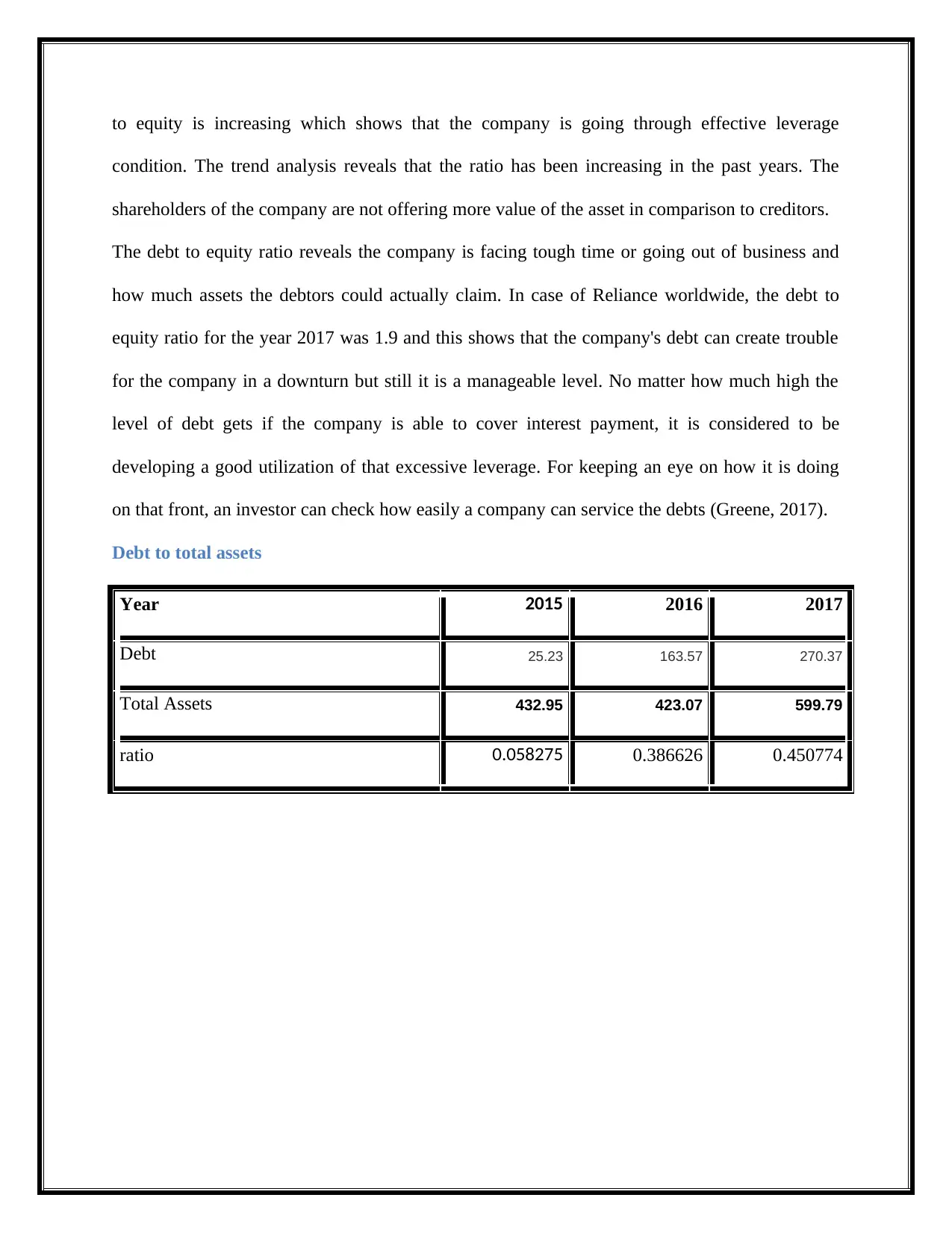
to equity is increasing which shows that the company is going through effective leverage
condition. The trend analysis reveals that the ratio has been increasing in the past years. The
shareholders of the company are not offering more value of the asset in comparison to creditors.
The debt to equity ratio reveals the company is facing tough time or going out of business and
how much assets the debtors could actually claim. In case of Reliance worldwide, the debt to
equity ratio for the year 2017 was 1.9 and this shows that the company's debt can create trouble
for the company in a downturn but still it is a manageable level. No matter how much high the
level of debt gets if the company is able to cover interest payment, it is considered to be
developing a good utilization of that excessive leverage. For keeping an eye on how it is doing
on that front, an investor can check how easily a company can service the debts (Greene, 2017).
Debt to total assets
Year 2015 2016 2017
Debt 25.23 163.57 270.37
Total Assets 432.95 423.07 599.79
ratio 0.058275 0.386626 0.450774
condition. The trend analysis reveals that the ratio has been increasing in the past years. The
shareholders of the company are not offering more value of the asset in comparison to creditors.
The debt to equity ratio reveals the company is facing tough time or going out of business and
how much assets the debtors could actually claim. In case of Reliance worldwide, the debt to
equity ratio for the year 2017 was 1.9 and this shows that the company's debt can create trouble
for the company in a downturn but still it is a manageable level. No matter how much high the
level of debt gets if the company is able to cover interest payment, it is considered to be
developing a good utilization of that excessive leverage. For keeping an eye on how it is doing
on that front, an investor can check how easily a company can service the debts (Greene, 2017).
Debt to total assets
Year 2015 2016 2017
Debt 25.23 163.57 270.37
Total Assets 432.95 423.07 599.79
ratio 0.058275 0.386626 0.450774
Paraphrase This Document
Need a fresh take? Get an instant paraphrase of this document with our AI Paraphraser
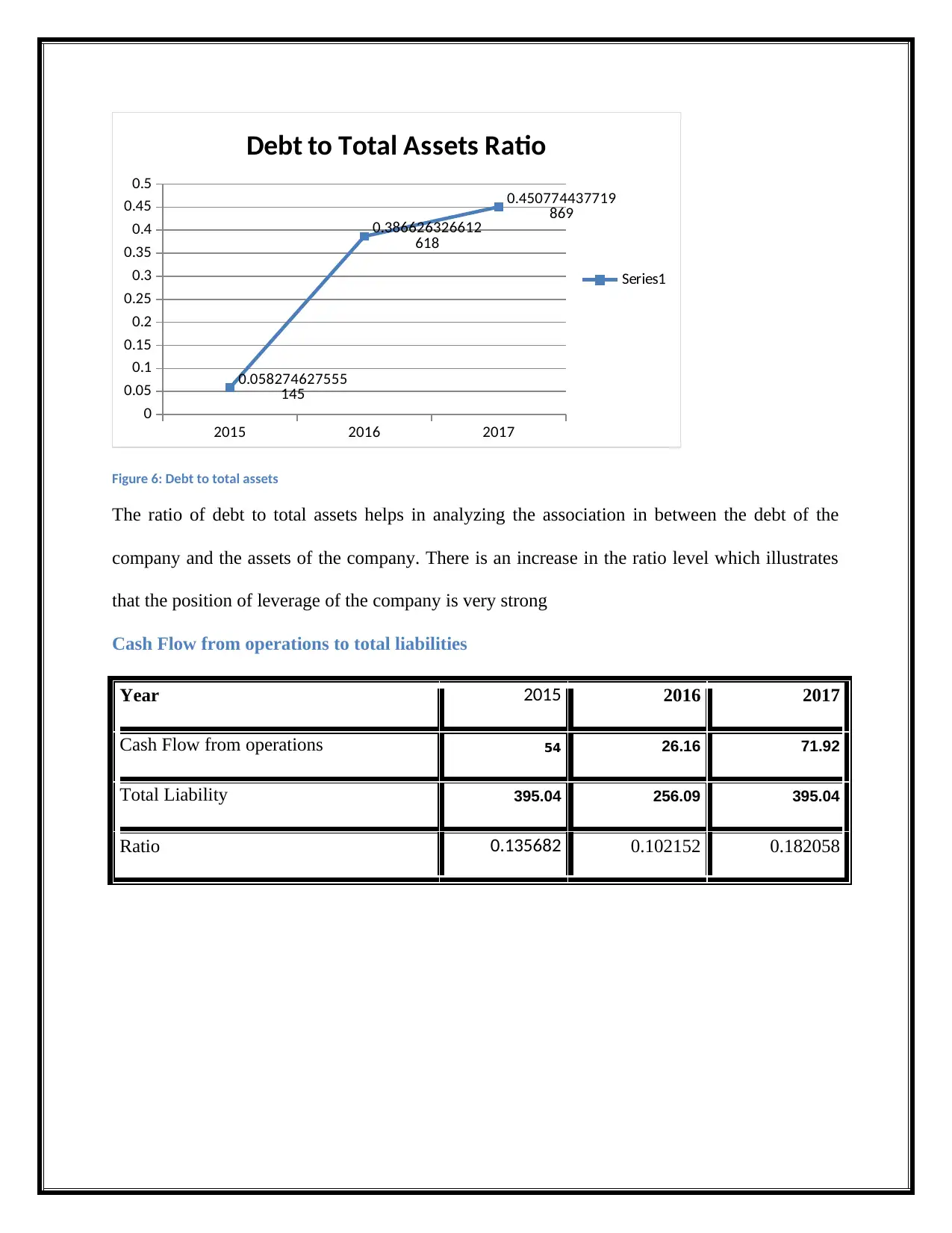
2015 2016 2017
0
0.05
0.1
0.15
0.2
0.25
0.3
0.35
0.4
0.45
0.5
0.058274627555
145
0.386626326612
618
0.450774437719
869
Debt to Total Assets Ratio
Series1
Figure 6: Debt to total assets
The ratio of debt to total assets helps in analyzing the association in between the debt of the
company and the assets of the company. There is an increase in the ratio level which illustrates
that the position of leverage of the company is very strong
Cash Flow from operations to total liabilities
Year 2015 2016 2017
Cash Flow from operations 54 26.16 71.92
Total Liability 395.04 256.09 395.04
Ratio 0.135682 0.102152 0.182058
0
0.05
0.1
0.15
0.2
0.25
0.3
0.35
0.4
0.45
0.5
0.058274627555
145
0.386626326612
618
0.450774437719
869
Debt to Total Assets Ratio
Series1
Figure 6: Debt to total assets
The ratio of debt to total assets helps in analyzing the association in between the debt of the
company and the assets of the company. There is an increase in the ratio level which illustrates
that the position of leverage of the company is very strong
Cash Flow from operations to total liabilities
Year 2015 2016 2017
Cash Flow from operations 54 26.16 71.92
Total Liability 395.04 256.09 395.04
Ratio 0.135682 0.102152 0.182058
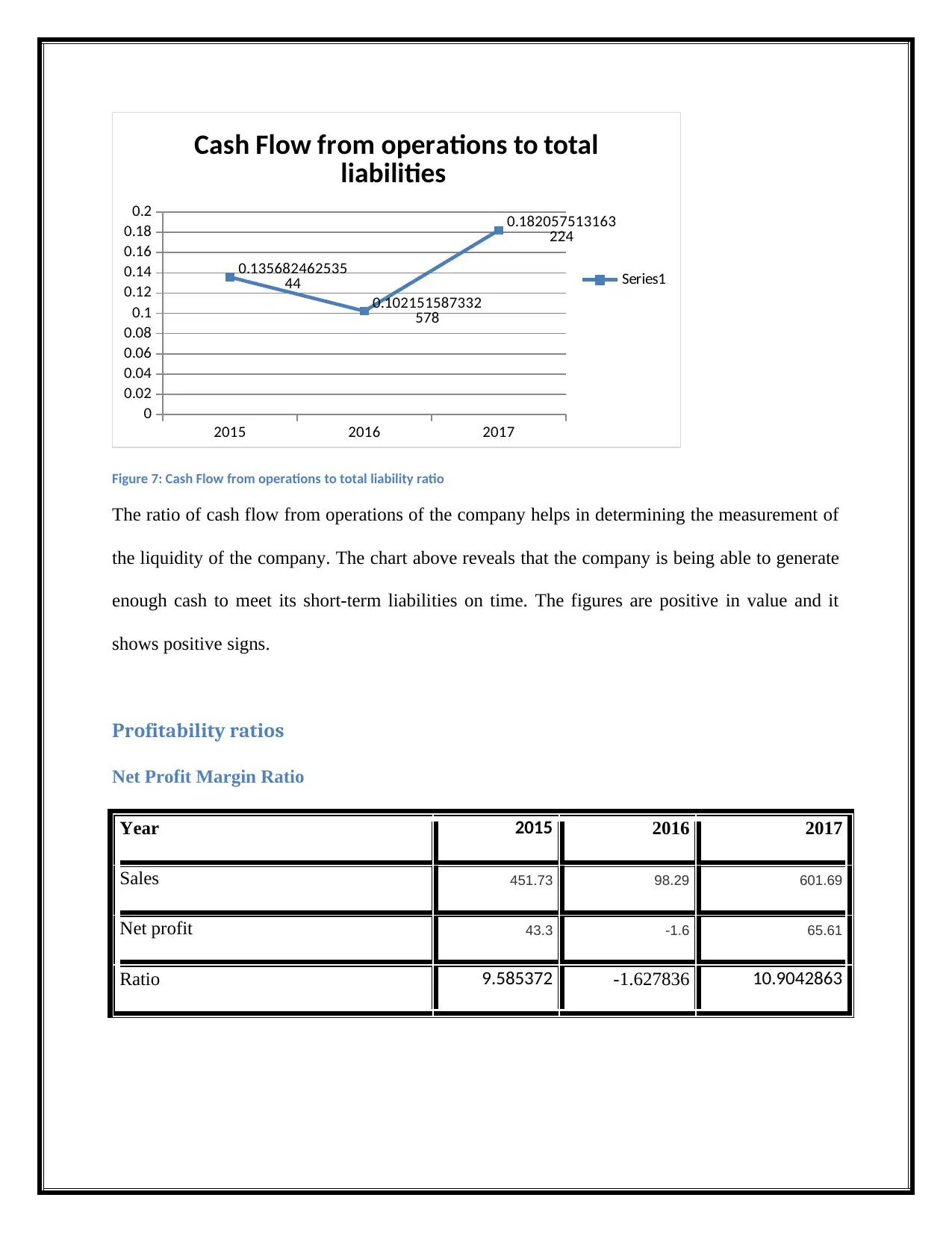
2015 2016 2017
0
0.02
0.04
0.06
0.08
0.1
0.12
0.14
0.16
0.18
0.2
0.135682462535
44
0.102151587332
578
0.182057513163
224
Cash Flow from operations to total
liabilities
Series1
Figure 7: Cash Flow from operations to total liability ratio
The ratio of cash flow from operations of the company helps in determining the measurement of
the liquidity of the company. The chart above reveals that the company is being able to generate
enough cash to meet its short-term liabilities on time. The figures are positive in value and it
shows positive signs.
Profitability ratios
Net Profit Margin Ratio
Year 2015 2016 2017
Sales 451.73 98.29 601.69
Net profit 43.3 -1.6 65.61
Ratio 9.585372 -1.627836 10.9042863
0
0.02
0.04
0.06
0.08
0.1
0.12
0.14
0.16
0.18
0.2
0.135682462535
44
0.102151587332
578
0.182057513163
224
Cash Flow from operations to total
liabilities
Series1
Figure 7: Cash Flow from operations to total liability ratio
The ratio of cash flow from operations of the company helps in determining the measurement of
the liquidity of the company. The chart above reveals that the company is being able to generate
enough cash to meet its short-term liabilities on time. The figures are positive in value and it
shows positive signs.
Profitability ratios
Net Profit Margin Ratio
Year 2015 2016 2017
Sales 451.73 98.29 601.69
Net profit 43.3 -1.6 65.61
Ratio 9.585372 -1.627836 10.9042863
⊘ This is a preview!⊘
Do you want full access?
Subscribe today to unlock all pages.

Trusted by 1+ million students worldwide
1 out of 25
Related Documents
Your All-in-One AI-Powered Toolkit for Academic Success.
+13062052269
info@desklib.com
Available 24*7 on WhatsApp / Email
![[object Object]](/_next/static/media/star-bottom.7253800d.svg)
Unlock your academic potential
Copyright © 2020–2026 A2Z Services. All Rights Reserved. Developed and managed by ZUCOL.




